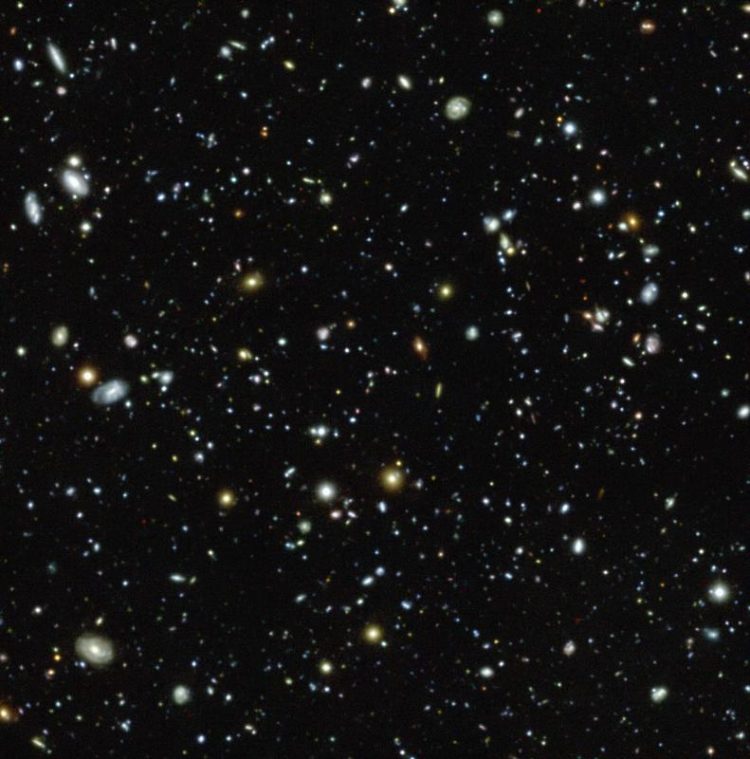The universe up close

The Hubble Ultra Deep Field seen with MUSE. Photo: ESO/MUSE HUDF collaboration
An international team of astronomers with the involvement of the University of Göttingen has conducted the deepest spectroscopic survey ever. Using the MUSE instrument (Multi Unit Spectroscopic Explorer) on European Southern Observatory’s (ESO) Very Large Telescope the scientists succeeded to measure distances and properties of 1600 very faint galaxies including 72 galaxies that had never been detected before. This dataset resulted in several science papers that were published in a special issue of the journal Astronomy & Astrophysics.
The astronomers focused on the Hubble Ultra Deep Field (HUDF), a much-studied patch of the southern constellation of “Fornax”. Three to five working groups independently analyzed the obtained data with their own specialist software.
To prevent mistakes, all teams compared their results among each other. Only if at least two or three teams came to the same result, the data of the distances and properties of the galaxies farthest away and oldest were included in the final catalogue. Scientists of Göttingen University formed one team that analyzed the spectroscopic information.
The much more advanced observation results compared to the images of the NASA/ESA Hubble Space Telescope and others are explained by the technology of the MUSE instrument: It splits up the light from every point in the image into its component colours to create a spectrum.
This allows scientists to measure the distance, colours and other properties of all the galaxies that can be seen with the MUSE instrument. Galaxies are the basic elements of the universe. They consist of millions to billions of stars.
“The MUSE data provide a new view of dim, very distant galaxies, seen near the beginning of the Universe about 13 billion years ago”, explains Göttingen Astrophysicist Professor Wolfram Kollatschny, who participated in the study.
“The instrument detected galaxies 100 times fainter than in previous surveys, adding to an already richly observed field and deepening our understanding of galaxies across the ages.”
Contact:
Prof. Dr. Wolfram Kollatschny
University of Göttingen
Faculty of Physics
Institute for Astrophysics
Friedrich-Hund-Platz 1, 37077 Göttingen
Phone +49 551 39-5065
Email: wkollat@astro.physik.uni-goettingen.de
http://www.aanda.org/articles/aa/abs/2017/12/contents/contents.html
http://www.astro.physik.uni-goettingen.de/~wkollat
Media Contact
All latest news from the category: Physics and Astronomy
This area deals with the fundamental laws and building blocks of nature and how they interact, the properties and the behavior of matter, and research into space and time and their structures.
innovations-report provides in-depth reports and articles on subjects such as astrophysics, laser technologies, nuclear, quantum, particle and solid-state physics, nanotechnologies, planetary research and findings (Mars, Venus) and developments related to the Hubble Telescope.
Newest articles

NASA: Mystery of life’s handedness deepens
The mystery of why life uses molecules with specific orientations has deepened with a NASA-funded discovery that RNA — a key molecule thought to have potentially held the instructions for…

What are the effects of historic lithium mining on water quality?
Study reveals low levels of common contaminants but high levels of other elements in waters associated with an abandoned lithium mine. Lithium ore and mining waste from a historic lithium…

Quantum-inspired design boosts efficiency of heat-to-electricity conversion
Rice engineers take unconventional route to improving thermophotovoltaic systems. Researchers at Rice University have found a new way to improve a key element of thermophotovoltaic (TPV) systems, which convert heat…



